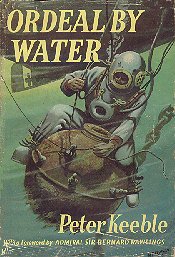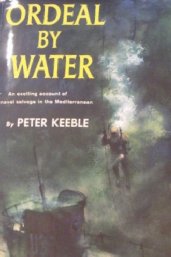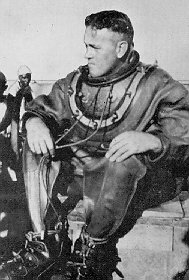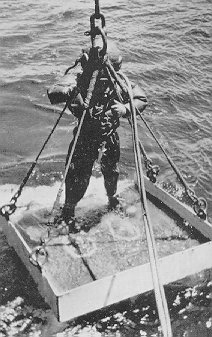 |
ORDEAL BY WATER
Peter Keeble
Longmans, Green and Co.
London.
First published 1957.
[pjs] |
|
On the right: Dust jacket of 1957 USA edition.
|
 |
Since taking up the sport
of scuba diving in 1969, I have often wondered what it would be like to
descend to the depths in a hard hat - standard dress that is. I have had
the opportunity, and indeed it is still available. Members of the Historical
Diving Association conduct ‘have a try at hard hat' days and I believe
several commercial units have similar sessions. Apart from the possibility
of claustrophobia, my hesitation is in simply relying on someone else for
your own safety. I appreciate that we do this most days of our lives, but
I just don't like the idea of being in someone else's hands when it comes
to going beneath the sea. So I've never had a go at it. Now, I need not
bother - I have read Peter Keeble's biographical Ordeal by Water.
Just one chapter in and I had a pretty good idea of what it was all about.
And I can tell you, I have no doubts as to what my reactions would be in
a hard hat - I would be shit scared. Such is the quality of Keeble's writing,
and his experiences, that I need not bother to try the real thing. His
vivid description of his first commercial dive is a classic in itself,
a brilliant portrayal of his fears and expectations, a description so realistic
that I started sweating at the thought of it. There is no difficulty in
putting yourself directly into Keeble's boots - virtual reality without
the headgear. That says much for Keeble's writing style. How fortunate
that we have had such an innovative and, dare I say, brave and daring man
who has not only experienced remarkable episodes in his life of salvage,
but also has the ability to put his thoughts and actions on paper.
| There are basically two
aspects of Ordeal by Water, set predominantly during the Second
World War in the Middle East. On the one hand we have the remarkable account
of what it is like to dive in standard dress, and on the other, we have
a superb description of the mechanics of marine salvage. Of the former,
several stand out. Firstly we have his very first dive at Port Elizabeth
before the war, an inquisitive dive for no reason than to give it a go.
"My first few minutes on the bottom had been spent fighting off a fearful
panic which swept over me the moment my suit was sealed and which had not
left me till a helper unscrewed my front glass and admitted a few lungfuls
of air to my craving, quaking body". |
 |
That would have been the end
of Keeble's self-admitted feeble attempt had the war not intervened in
his life as a marine engineer. In Massawa (in the Red Sea), he was placed
in a position where it was inevitable that he went down again. He was a
Royal Navy salvage officer. His portrayal of what is really his first commercial
dive is nothing short of brilliant. And as nearly disastrous as his first.
"In the darkness I lost my balance and began to flounder, and as my sense
of direction fled with uncanny suddenness, panic flared up in me. My heart
lurched and thumped , and fear increased my respiration. I heard my breathing
rasping fast and noisy in my helmet." To think that from these inauspicious
beginnings, arose a master diver of the highest order, is quite remarkable,
and ably demonstrates the dedication and initiative of the author. But
it put me off ever thinking of taking a ‘try-dive' at hard hat. And there
was more to come that would seal any extravagant thoughts of having a go.
Diving off a rock wharf demolished by retreating Germans, he came across
a rather undamaged diving pump on the seabed, only to realise within seconds
that it was, indeed, his own pump, and it was not where it should have
been, having decided to also take a tumble of the damaged jetty to join
the diver it was supposed to support. In most circumstances this would
have been the end of the diver; although the remaining air in the suit
would have been sufficient for a few minutes before suffocation, there
was no air for buoyancy to raise the diver off the seabed (in this instance
there being no staging platform or shot line to grasp). Fortunately the
Germans had done a reasonable job of destroying the jetty in stages, and
Keeble was able to climb up the jetty wall in steps. This is not a situation
a standard dress diver likes to be in. But there is worse. Fortunately
the author keeps the description of his witness of a ‘squeeze' victim to
a minimum. The unfortunate plight of the diver who descends rapidly is
such that he cannot maintain equalization pressure and the sea literally
forces his body - his whole body - into the helmet. Not a pleasant sight.

Lt-Commander Peter Keeble
is brought
on board after his marathon
dive to the
German submarine U-307 in
230 ft. |
The most remarkable description
of a dive however is that which Keeble has on a German submarine that went
down in 230 feet with half its crew still aboard. U307 had a ‘secret gadget'
in the control room that, apparently, used infra red rays to beam in on
a potential target at night, and this was required by the Royal Navy for
analysis. It meant entering the submarine though the conning tower hatch,
entering the control room in complete darkness, and removing the booby-trapped
device. A mockup was made on shore of the sub's layout and, blindfolded,
Keeble practised moving about inside the submarine. The description of
the dive did enough to raise what few hairs I have on the back of my neck.
He actually had to cut through a German officer's body jammed in the hatch.
On handing the device over to the Navy boffins, they asked how he managed
to defuse the booby trap. "Christ! I forgot all about it!" he said. |
On the theme of salvage, the
book has much to offer, and serves to demonstrate what remarkable achievements
can be made with determination and ingenuity. Keeble has both and his raising
of ships, dry docks, and the development of underwater cutting techniques
of the highest order is remarkable - yes, I am using that word again, but
there is no other. You cannot have but the highest admiration for men who
can perform beyond expectations, and for the team spirit that necessarily
exists in a diving team.
Ordeal by Water is a classic
by way of its prose. Apart from a brief mention of improvements in underwater
cutting, there is nothing new in the way of development of technique
nor equipment. It is simply the descriptions of the dive, and the salvage,
that raises this book to classic level. It is eminently readably,
with elements of suspense, intrigue, excitement and fear. A truly - remarkable
- book.
Readability: Exceptionally
well written, with an educated yet relaxed style. Each page is literally
‘packed with interest'. Of importance to those interested in standard dress
diving, and military salvage during World War 2.
General comment: Despite
the fanciful cover, this I not a book about macho bravado. Keeble appears
to be a humble and honest man of the highest integrity, and I have no reason
to doubt this. The book has credibility.
Classic rating: I'd give
it a seven out of ten.
Availability: Scarce but
not rare.
We have had the occassional
copy in stock. See second-hand books, or ask us to look out for a copy.
|





